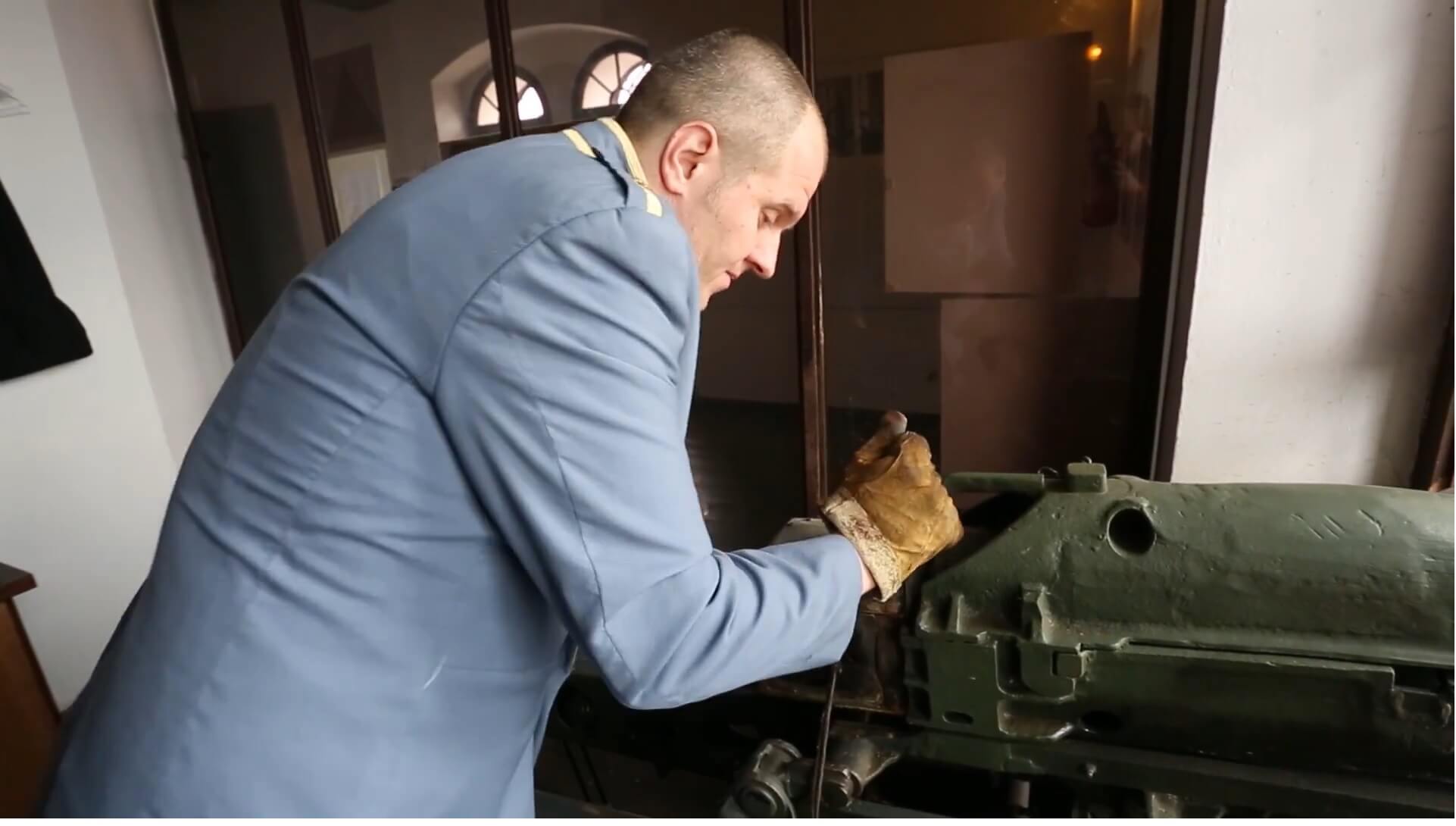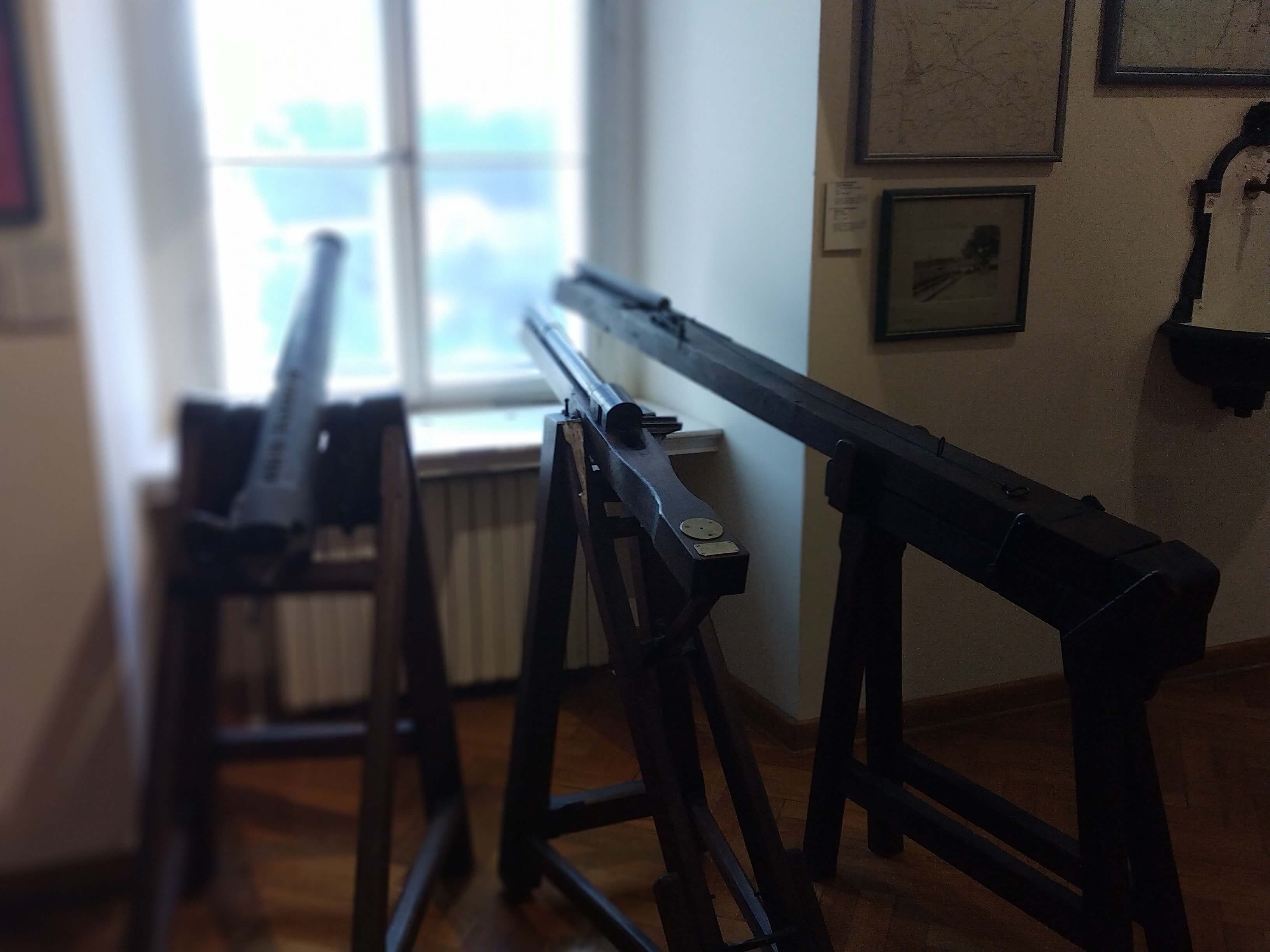Croatian Short Documentary 'Noon Shot' Selected at Lift-Off Festival
April 8, 2022 - The Croatian short documentary 'Noon Shot', about Stjepan Možar, the gunner of the famous Grič cannon in Zagreb, is directed by Stanka Gjurić and has been selected at the Lift-Off festival in London.
Zagreb is a city that is characterized, among many things, by the symbols and sights that one can find in different corners of the Croatian capital. One, in particular, generates a huge sense of belonging among its inhabitants and has recently returned to its operations after a long time of silence: the Grič cannon. The first time the cannon was fired to announce noon in the city of Zagreb was in 1877, as part of an initiative promoted by the writer, publicist, and city councilor, Đuro Deželić. The cannon has been the pride and joy of the citizens of Zagreb for over a century, and according to legend, it even saved the city from an invasion by the Ottoman Empire. If you want to know more about the legend, click here.
It was originally located in the building of the Hydrometeorological Institute, and today it is located in the Lotrščak tower on Grič. It is a mountain cannon type Howitzer M116, caliber 76mm, and its range is 7929 meters, and the volume of the shot is 140 decibels.
The cannon stopped during the First World War and resumed its activity, not until 1928. Since then it has not stopped announcing noon in Zagreb, until almost two years ago during the earthquake that hit the Croatian capital in March 2020.
It took two months for the cannon to restart, and it has been firing at noon between May 11, 2020, and December 29 of that same year. It last fired just 20 minutes before the earthquake that affected the Sisak-Moslavina region, with the epicenter in Petrinja, and which was also strongly felt in Zagreb. The cannon, which finally returned to work this year on February 14th, had been inactive since then.

Filmmaker Stanka Gjurić, director of the Croatian short documentary 'Noon Shot'
The history of the canyon is very rich in details and the interest it generates is irrefutable, and that is how the idea was born for the Croatian filmmaker Stanka Gjurić to make a short documentary. However, it is not about the cannon that the Croatian short documentary revolves. The film is about Zagreb gunner Stjepan Možar (today, unfortunately, deceased) who came to the Lotrščak tower on Grič every day to shoot from the cannon and thus mark noon (Možar fired from the Grič cannon every day for 35 years).
Stanka Gjurić's short documentary, 'Noon shot' has entered the official selection of the global network of the Lift-Off film festival in London (Great Britain). Lift-Off Global Network is based at one of the most famous film studios on the planet. Their headquarters at Pinewood Studios in the UK is at the heart of the film industry. The Lift-Off Film Festival Global Network is the only worldwide exchange of true independent cinema.

Congratulations to our artist on her hard work, perseverance and, of course, success in presenting her own films around the world: France, Italy, Greece, Portugal, Spain, Bosnia and Herzegovina, Switzerland, Slovenia, Egypt, Canada, Serbia, USA, South Africa, Argentina, India, Russia, Austria, Brazil, Great Britain, etc. With her short films, to date, Gjurić has won 15 international awards.
Learn more from Croatian filmmaker Stanka Gjurić HERE.
If you are looking for the most complete information to enjoy Zagreb, be sure to check out Total Croatia, Zagreb in a Page guide HERE. Available in nine languages!
For more, check out our lifestyle section.
How Far Can Zagreb Grič Cannon Fire? Ideal Conditions View of the Fire Range
July 21, 2021 - Ever wondered about the Zagreb Grič Cannon fire? TCN reporter Ivor Kruljac played with Google maps to provide an answer in ideal conditions.
While Zagreb Grič Cannon did not shoot at the time of writing this article, it is still one of the key symbols of Zagreb, and memories of its bang during midday is a vital part of the living in Zagreb experience.
As TCN previously wrote, the Grič Cannon was first introduced on January 1, 1877, and was located at the State's Meteorology department, back in the times when Croatia was part of the Austro-Hungarian Monarchy. It wasn't until 1927 that it was moved to Lotršćak, where it is situated to this day. In addition, the current cannon serving this purpose is actually the fifth to do the job and was donated to Zagreb by the Yugoslavian National Army (JNA), during Universiade.
Apart from signaling noon, the old legend says the Grič Cannon also served a defensive purpose. As TCN previously wrote, legend has it that the Ottoman commander Hasan Pasha (Hasan Paša) settled his army along the coast of the Sava river, in today's area of Novi Zagreb. He was preparing to cross the river and invade the city, but before that, he was about to have lunch, and Zagreb fired a cannon in the Ottomans' direction, close to Hasan, blasting a chicken he wanted to eat. The shot scared the hell out of the Ottomans, and they retreated, leaving Zagreb totally intact.
The legend itself is part of a book titled ''The Grič Cannon legend'' in which writer Dubravko Horvatić has gathered 20 Croatian legends, and the book is a mandatory book report title for Croatian pupils in the third year of elementary school.
 Preparing the cannon, screenshot / PIXSELL
Preparing the cannon, screenshot / PIXSELL
Legend vs facts
With the story taking place way back in the 16th century, it's obvious the tale is just a legend as the cannon wasn't introduced until the 19th century. Still, it's a cool story, and a bit of a twisted mind can't but help think: what's the range you could actually shoot with the Grič Cannon?
As the Wikipedia page says, and as a member of the Zagreb Tourist Board in Lotrščak tower confirmed to this sleuth reporter, the current cannon's range is 7,929 metres (almost eight kilometres), and the sound of the blast has a solid 140 dB.
Legend says Hasan Paša was on the coast of the Sava river, which means he was in southern Zagreb, and sure enough, the Grič cannon is facing south from Lotrščak. The cannon floor also has windows looking in each direction, meaning you could move the cannon to north, west, or east.
When playing with Google maps distance measuring tools, you can see that the smallest distance between the Sava river and Lotrščak is, give or take, about 3,1 kilometres. So, the current cannon, under the right angle, could easily make that shot.

The distance between Fort Lotrščak and Sava river, screenshot / Google Maps
Apart from the possibilities of buildings and hills messing up the shot, there are other things that need to be taken into consideration. As the Department of the Army U.S. Marine Corps identified back in 1996, in their manual, there are many factors that affect artillery fire.
Muzzle velocity, projectile weight, range wind, air temperature, air density, even the rotation of the Earth, not to mention the overall condition of the barrel, all of which are challenges that could limit the cannon's full potential. And yes, Google maps isn't really the most precise tool on the planet, but let's take a shot in the dark and see how far the Grič cannon could actually fire (keep in mind these projections are made solely based on the maximum range, and the factors aren't taken in account but are mentioned for the sake of trivia knowledge).
South! Aim! Fire!
Let's start from the cannon's current position. Assuming no buildings, hills, or anything else gets in the way, and you're a physics genius that managed to isolate yourself in Lotrščak with live ammo and achieve a clear straight shot, your cannonball makes an impact all the way in line with Donji Čehi (but a bit away to the east from that place). Donji Čehi, along with Gornji Čehi, used to be independent villages but are today part of the City of Zagreb. With only 1,72 km2 of length, the place is inhabited by 232 residents, based on a 2011 census.

Grič Cannon maximum range to the south, screenshot / Google Maps
West! Aim! Fire
Continue clockwise and set your cannon to take a shot towards the west, with a range of little under eight kilometres. You can score all the way to Krnska street in Gajnice. Krn is both a name of a mountain and a peak (2244) in neighbouring Slovenia. The mountain is a part of the Triglav National Park in Slovenia (and if this side note makes your attention turn to Slovenia, be sure to check our friends at Total Slovenia News). Gajnice is a neighbourhood in Zagreb that is inhabited by around 10,000 residents. The neighbourhood is notorious for its pretty lousy connection with the rest of the Zagreb, and local residents often complain about infrequent buses that connect them to Črnomerec from where they can travel to the city centre. Well, at least, the centre doesn't aim at them with a cannon.

Grič Cannon maximum range to the west, screenshot / Google Maps
North! Aim! Fire!
The new target, or perhaps better to say lucky shot, lies towards the north. Don't worry about Medvednica mountain getting in the way of a clear shot towards Zagorje, as the range isn't long enough. The shot will hit Medvednica mountain, more precisely, to the close proximity of Tusti Vrh. This location is 648 metres above sea level and serves as a stand for a communication station with some antenna polls. But, there's no need to shoot the place up and destroy a lovely piece of nature, which also serves as an important social role in regards to telecommunication. Instead, you can visit the place as the Gračani trail leads there.

Grič Cannon maximum range to the north, screenshot / Google Maps
East! Aim! Fire!
Finally, it's time to ruin someone's day in east Zagreb (fortunately, no person was hurt during these simulations in reality). Specifically, this applies to whoever lives in Retkovec III near Bruma Interijeri d.o.o., a company specialised in woodwork.
Petkovic is a neighbourhood that is part of the Dubrava district. It's mostly a residential place, like much of eastern neighbourhoods considered to be a bit of a rough area to live in. Still, things aren't as bad as they were as before.

Grič Cannon maximum range to the east, screenshot / Google Maps
Shooting blanks
Again, it's worth noting these projections aren't accurate science and imply conditions which are perfect. Of course, in an ideal world we wouldn't need firearms and everyone would be living in peace. In reality, where these ideal conditions don't apply, residents of the aforementioned areas, but also citizens in general, can be relaxed, as the ranges are irrelevant.
 Shots fired aftermath, screenshot / PIXSELL
Shots fired aftermath, screenshot / PIXSELL
''It's worth noting the cannon is modified, and it can't fire live ammo,'' warned the Zagreb TB official, who was a bit puzzled as to why I would even ask her for the potential range of a weapon overlooking the Croatian capital from Fort Lotrščak. But, as I'm sure any researcher will confirm, scientific curiosity often calls for asking controversial questions.
Learn more about Zagreb on our TC page.
For more about history in Croatia, follow TCN's dedicated page.
Zagreb Grič Cannon: Explosive Noon Reminder
July 9, 2021 - Zagreb Grič Cannon - a reminder of noon, and a reason to avoid the centre if you aren't a fan of loud sounds. Get your noise-canceling headphones and read about the cannon's history, courtesy of TCN reporter Ivor Kruljac.
If you find yourself walking around a wider Zagreb centre (such as Savska Cesta or Marin Držić Avenue) around noon, and you focus on the sounds of the city, you may notice a weird sound in between traffic and people passing. An unusual sound, as if someone dropped a heavy box. But, if around noon, you find yourself at Ban Jelačić square or upper town, you will hear a clear and loud BANG! Fear not, as this is not a terrorist attack, and you weren't lied to when your tourist agency swore to god Zagreb is safe from such horrors. The heart-stopping bang is a signifier of noon. If you hear a boom at 11:59 or 12:01, your watch is behind a minute. The cannon states that clear and very, very loud.
Loudest time checker you could think of
Grič cannon first started signaling noon on January 1, 1877, and was located at the State's Meteorology department, back in times when Croatia was part of the Austrian-Hungarian Monarchy. It wasn't until 1927 that it was moved to Fort Lotršćak where it is situated today.
According to the Klovićevi Dvori Gallery's official website, Fort Lotrščak was named after a bell and comes from campana latrunculorum, which is Latin for „Bell of Thieves“ that rang before closing city gates. Historians aren't exactly sure what the Fort looked like in medieval times, although it is speculated based on old sketches that it had only two floors. It wasn't until 1857 that romanticistic architecture gave the fortress today's four floors and an additional tower at the very top (from which you have a breath-taking view of Zagreb today).

Fort Lotrščak © Ivor Kruljac / Total Croatia News
In the 17th century, the Fort served as trading storage and had various other ways to adapt to the need of Zagreb and Zagreb's citizens at different times. At one point, when the City was out of money to restore and repair the Fort, it gave Lotrščak to citizens for rent. Citizens who wanted the Fort also had the obligation of maintaining it, and in case of enemy assault, it was to be returned back to the City for defense purposes.
Warning shot
Speaking of defense purposes, an old legend says how this cannon managed to save Zagreb with a single shot from the Ottoman conquerors. Legend has it that the Ottoman commander Hasan Pasha (Hasan Paša) settled his army at the coast of the Sava river, in today's area of Novi Zagreb. He was preparing to cross the river and invade the city. But before that, he was about to have lunch one day, and Zagreb fired from the cannon in the Ottoman's direction, close to Hasan and blasting a chicken he wanted to eat. The shot scared the hell out of the Ottomans and they retreated, leaving Zagreb intact.
Changing arsenal
Over the course of time, there were five different Grič cannons that served the purpose of signaling noon. The current canon was given during Zagreb's Univerzijada in 1987, courtesy of the Yugoslavian National Army (JNA) as Croatia at the time was part of the Socialist Federal Republic of Yugoslavia (SFRJ).
As for the first three, you can find them today in the collection of the Zagreb City Museum. The first cannon originated in 1876 and was replaced by the second cannon in the unidentified year at the end of the 19th century. The third cannon you can see in Zagreb City Museum, and the first that was situated on Lotrščak fort, was introduced in 1928, and it was made by restoring a Polish cannon from 1912.

Three cannons showcased at Zagreb City Museum © Ivor Kruljac / Total Croatia News
So finding yourself in front of Fort Lotrščak (whose entrance is located right next to the Upper town funicular station) is not recognizable if you are not a fan of loud noise as it can give you a sound fright even down below at Jelačić square and the surrounding area. But, for the brave ones, the Grič cannon can provide a unique souvenir from Zagreb. It doesn't use live ammo (the cannon is modified so it can't), but it does fire several pieces of thick cardboard that then flies down to the area underneath Lotrščak's entrance and smelling like gunpowder.
Ceased fire
Despite being a regular background sound for the experience of living in Zagreb, Grič cannon went through periods when it ceased fire and stopped making statements. The first such instance was World War I and then followed by the war in the nineties. Most recently, the cannon was silenced after the Zagreb earthquake on March 22, 2020, but it re-fired hot and heavy sometimes in May 2020. However, followed by the December 29th Petrinja earthquake, which was also felt heavy in Zagreb, the cannon is silent even today.
„We are not quite sure when it will re-fire“, briefly commented the Zagreb Tourist Board member that welcomed me in Fort Lotrščak, one of the locations where Zagreb TB has a regular stand. Still, despite the cannon being silenced, you can climb and sightsee Lotrščak, the famous cannon as well as the watchtower on top of the Fort, for the prize of 20 kunas.

One of the exhibitions at Lotrščak © Kula Lotrščak
The Lotrščak Fort address is Tomićeva 9, and the Fort occasionally also hosts various exhibitions at times too. But, the cannon is a regular feature, and there are lots of info on the history of the cannon and the Fort itself there too on the walls- both in English and Croatian.
Learn more about Zagreb on our TC page.
For more about history in Croatia, follow TCN's dedicated page.
Gric Cannon: Zagreb's 143 Year Tradition Ceases Following Earthquake
Have you ever been in Zagreb and heard a loud bang out of the blue and wondered if the city was under attack or that a bomb had gone off? Probably. Never fear! Firing from the Gric cannon is an old Zagreb tradition and has been going on for more than 143 years, with a short break taking place during the First World War.
As Poslovni Dnevnik writes on the 2nd of April, 2020, current gunner Alem Tutundzic is the fifth generation of what are known as the ''Gric gunners''. He has been doing this job or eleven long years now, after succeeding Stjepan Mozar.
The famous Gric cannon, a long standing and very well known symbol of the City of Zagreb, has been announcing when it is noon to Zagreb's residents every single day since way back in 1877. Every day at 12 o'clock, the Lotrscak tower and other buildings in Zagreb's Old Town are shaken by a huge ''boom'', giving quite the shock to those who aren't familiar with the sound.
The Gric cannon has not been performing its function since the 28th of March, 2020, for the very first time since it took a temporary break during the First World War. The actual cannon that is still in use today in the tower has been around since 1987.
The city confirmed the circulating information about the Gric cannon ceasing fiting. They said the shots from the Gric cannon and the resulting vibrations further upset the citizens of Zagreb's Upper Town (Gornji Grad) following the recent devastating earthquake and all of the smaller but no less disturbing ones that followed it.
After consultation with the Crisis Management Office and Crisis Headquarters, a decision was made to put a temporary stop to the daily noon tradition from the 28th of March until further notice.
For more information about Zagreb, follow Total Zagreb or check out Zagreb in a Page for all you need to know about the bustling Croatian capital city.


